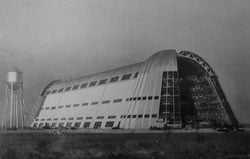This article is more than 1 year old
Silicon Valley struggles to save toxic landmark
Most historic poisonous structure for miles
On the morning of May 12, 1932 — long before the area was transformed into the nation's technology hub— more than 100,000 spectators braved traffic on the still-uncompleted Bayshore Freeway to congregate at the Mountain View-Sunnyvale border.
The crowd had arrived to watch the arrival of "sky-queen," a jewel of America's lighter-than-air craft era dock at Hangar One. Standing at 211 feet, the still-incomplete Navy structure would be home only briefly to the USS Akron as it made its way to Lakehurst, New Jersey.
Less than a year later, the "sky-queen" would crash off the coast of New Jersey, killing 73 of the 76 officers aboard — among them Admiral William Moffett who helped establish the base that housed Hangar One, and for whom the airfield is now named. Eight days after the tragedy, the station was commissioned.
For 71 years, Hangar One has remained a cherished landmark in Silicon Valley. And for 71 years, the hangar has poisoned the landscape around it.
The structure's toxic secret wasn't discovered until 2003 when Navy, NASA, US Environmental Protection Agency and local government officials began looking for a source of contamination in the nearby Moffett Field wetland, which flanks the NASA Ames center.
Several endangered species make their home in the adjacent tidal marsh, such as the California clapper rail and Alameda song sparrow — which spend their days fluttering about the waters that have been tainted by polychlorinated biphenyl, DDT and various toxic heavy metals.
Officials first assumed the pollution came from the Moffett airfield runway, but the chemical trail soon lead environmental investigators on a b-line for the massive blimp garage instead.
It was already known that Hangar One was bad news. Its insides are filled with chemicals known to cause cancer and neurological damage, its outsides are coated with lead-based paint and the roof panels are made of materials high in asbestos and PCB. What wasn't apparent, however, was that toxins were washing off the hangar every rainy season and turning the marsh into a chemical broth.
The debate on whether to destroy Hangar One or pay more to clean it up has made little progress over the years. The Navy, NASA and government officials have created the perfect storm of long-term environmental studies and government bureaucracy to analyze the situation. The Navy wants to destroy the building for $12m and be done with it, but an organization called Save Hangar One Committee has fought tooth and nail to preserve one of Silicon Valley's last few remaining historical structures.

Hanger One
Last evening, attendance was sparse at the Restoration Advisory Board Meeting as Navy officials reported that no progress has been made since the last meeting two months ago.
Solutions continue to trickle in. One private group is seeking funding to pay for Hangar One preservation costs to turn the hangar into a NASA museum.
A local architect suggests that Hangar One could be covered in a Teflon-coated Fiberglas fabric, sealing the outer toxins from leaking into the marsh. The cost for the installation of materials and fabric would run about $12m — money NASA doesn't have to spare.
What remains to be seen is if Silicon Valley cares enough about a landmark to raise the money. Mountain View and the surrounding suburbs seem content to let historical sites such as the original building for Shockley's Lab become an abandoned fruit stand, and simply slapping a historical marker on the original Fairchild building before calling it a day.
Apparently, toxic material isn't enough to light a fire under anyone's ass. Maybe when mutant Alameda song sparrows start attacking, we'll be singing another tune. ®
